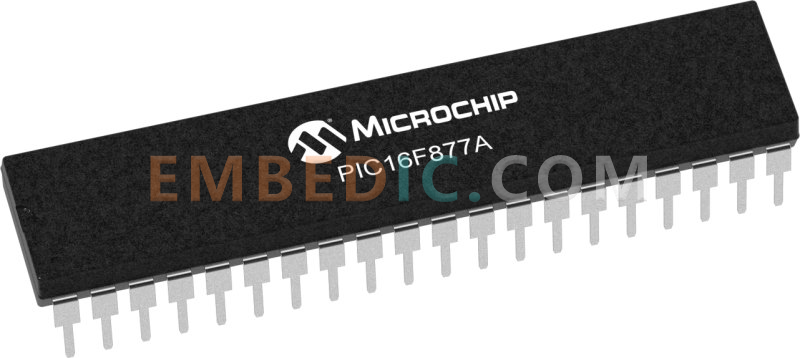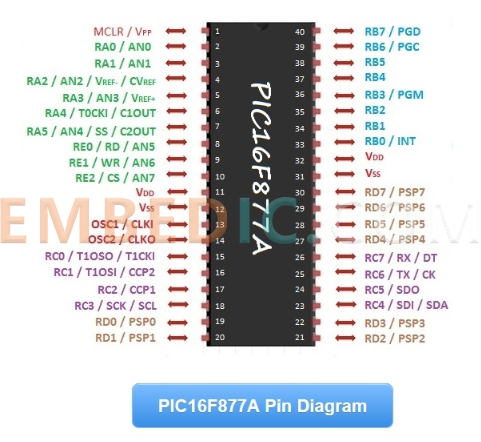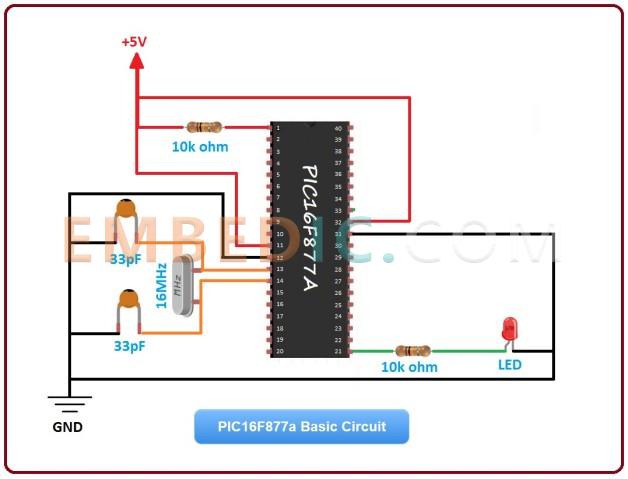The PIC16F877A microcontroller is a powerful and versatile integrated circuit that has become a cornerstone in the world of embedded systems and microcontroller programming. Developed by Microchip Technology, the PIC16F877A is a member of the PIC16 family and boasts an array of features that make it a popular choice among electronics enthusiasts, students, and professionals.
In this article, we will explore the datasheet, pinout, and applications of the PIC16F877A microcontroller, providing valuable insights for both beginners and experienced designers looking to harness the capabilities of this versatile microcontroller in their projects.
The PIC16F877A is a popular 8-bit microcontroller from the PIC (Peripheral Interface Controller) family, developed by Microchip Technology (formerly known as Microchip Technology Inc.). It is widely used in various embedded systems and electronic projects due to its versatility and features.


|
Pin Number |
Pin Name |
Description |
|
1 |
MCLR/Vpp |
Master Clear (Reset) input used during programming. |
|
2 |
RA0/AN0 |
Analog pin 0 or 0th pin of PORTA. |
|
3 |
RA1/AN1 |
Analog pin 1 or 1st pin of PORTA. |
|
4 |
RA2/AN2/Vref- |
Analog pin 2 or 2nd pin of PORTA, also serves as Vref- for ADC. |
|
5 |
RA3/AN3/Vref+ |
Analog pin 3 or 3rd pin of PORTA, also serves as Vref+ for ADC. |
|
6 |
RA4/T0CKI/C1out |
4th pin of PORTA, Timer0 clock input or comparator output. |
|
7 |
RA5/AN4/SS/C2out |
Analog pin 4 or 5th pin of PORTA, also serves as SS for SPI. |
|
8 |
RE0/RD/AN5 |
Analog pin 5 or 0th pin of PORTE, also used for digital I/O. |
|
9 |
RE1/WR/AN6 |
Analog pin 6 or 1st pin of PORTE, also used for digital I/O. |
|
10 |
RE2/CS/AN7 |
7th pin of PORTE, also used for digital I/O. |
|
11 |
Vdd |
Positive supply voltage for logic and I/O pins. |
|
12 |
Vss |
Ground reference for logic and I/O pins. |
|
13 |
OSC1/CLKI |
External oscillator or clock input. |
|
14 |
OSC2/CLKO |
External oscillator or clock output. |
|
15 |
RC0/T1OSO/T1CKI |
0th pin of PORTC, Timer1 output or clock input. |
|
16 |
RC1/T1OSI/CCP2 |
1st pin of PORTC, Timer1 input or CCP2 (PWM/Comparator) function. |
|
17 |
RC2/CCP1 |
2nd pin of PORTC, CCP1 (PWM/Comparator) function. |
|
18 |
RC3/SCK/SCL |
3rd pin of PORTC, SCK (SPI) or SCL (I2C) function. |
|
19 |
RD0/PSP0 |
0th pin of PORTD, Parallel Slave Port bit 0. |
|
20 |
RD1/PSPI |
1st pin of PORTD, Parallel Slave Port bit 1 or SPI function. |
|
21 |
RD2/PSP2 |
2nd pin of PORTD, Parallel Slave Port bit 2. |
|
22 |
RD3/PSP3 |
3rd pin of PORTD, Parallel Slave Port bit 3. |
|
23 |
RC4/SDI/SDA |
4th pin of PORTC, Serial Data In (SDI) or I2C data function. |
|
24 |
RC5/SDO |
5th pin of PORTC, Serial Data Out (SDO) function. |
|
25 |
RC6/Tx/CK |
6th pin of PORTC, USART Transmit (Tx) or clock function. |
|
26 |
RC7/Rx/DT |
7th pin of PORTC, USART Receive (Rx) or data function. |
|
27 |
RD4/PSP4 |
4th pin of PORTD, Parallel Slave Port bit 4. |
|
28 |
RD5/PSP5 |
5th pin of PORTD, Parallel Slave Port bit 5. |
|
29 |
RD6/PSP6 |
6th pin of PORTD, Parallel Slave Port bit 6. |
|
30 |
RD7/PSP7 |
7th pin of PORTD, Parallel Slave Port bit 7. |
|
31 |
Vss |
Ground reference for logic and I/O pins. |
|
32 |
Vdd |
Positive supply voltage for logic and I/O pins. |
|
33 |
RB0/INT |
0th pin of PORTB, External Interrupt input. |
|
34 |
RB1 |
1st pin of PORTB. |
|
35 |
RB2 |
2nd pin of PORTB. |
|
36 |
RB3/PGM |
3rd pin of PORTB, used for programming or digital I/O. |
|
37 |
RB4 |
4th pin of PORTB. |
|
38 |
RB5 |
5th pin of PORTB. |
|
39 |
RB6/PGC |
6th pin of PORTB, used for programming or digital I/O. |
|
40 |
RB7/PGD |
7th pin of PORTB, used for programming or digital I/O. |
The Specification of PIC16F877A microcontroller are:
According to the specification, here are the features of PIC16F877A,
8-bit CPU Core: The microcontroller features an 8-bit RISC (Reduced Instruction Set Computing) CPU core, which allows for efficient and compact code execution.
Flash Memory: It has a significant amount of flash memory for storing the user's program code. This memory is non-volatile, allowing the program to be retained even when power is turned off.
RAM and EEPROM: The device includes RAM (Random Access Memory) for temporary data storage during program execution, and EEPROM (Electrically Erasable Programmable Read-Only Memory) for non-volatile data storage.
Peripheral Integration: The PIC16F877A offers a variety of on-chip peripherals, including:
Timers and Counters: Useful for generating time delays, measuring time intervals, and creating PWM signals.
Analog-to-Digital Converter (ADC): Converts analog signals (such as sensor readings) into digital values for processing.
Digital I/O Ports: A set of general-purpose digital I/O pins for interfacing with external devices.
Serial Communication Modules: USART (Universal Synchronous Asynchronous Receiver Transmitter) for serial communication.
Pulse Width Modulation (PWM): Used for generating analog-like signals, useful for applications like motor control and LED dimming.
Interrupt System: Supports hardware and software interrupts for efficient event handling.
Watchdog Timer: A timer that resets the microcontroller if the software hangs or crashes.
Clock Options: The microcontroller can be operated using different clock sources, including an internal oscillator and an external crystal oscillator, providing flexibility in choosing the appropriate clock speed for your application.
Low Power Modes: The device offers various low-power modes, allowing you to conserve energy when the microcontroller is not actively processing data.
Wide Operating Voltage Range: The microcontroller can operate within a wide voltage range, making it suitable for both battery-powered and industrial applications.
On-Chip Oscillator: The internal oscillator eliminates the need for an external clock source in many applications, reducing component count and overall system cost.
Development Tools: Microchip provides a range of development tools, including compilers, integrated development environments (IDEs), and programming/debugging hardware, to aid in the development process.
Wide Range of Applications: Due to its features and flexibility, the PIC16F877A is suitable for applications such as industrial control, automation, robotics, consumer electronics, automotive systems, medical devices, and more.
Here is the basic circuit of pic16f877a,

Programming the PIC16F877A microcontroller involves writing code that specifies how the microcontroller should function and interact with its peripherals. Here's an overview of the steps involved in programming the PIC16F877A:
Step1. Select a Programming Language
You can write code for the PIC16F877A in languages like C, assembly language, or even high-level languages with appropriate compilers or tools.
Step2. Choose a Development Environment
Select a development environment that supports PIC microcontrollers. Microchip's MPLAB X IDE is a popular choice. It provides a code editor, compiler, debugger, and simulation tools.
Step3. Write Your Code
Create your program logic based on your application's requirements. This may involve configuring peripherals like GPIO, timers, ADC, UART, etc.
Step4. Compile Your Code
Use the appropriate compiler to translate your source code into machine-readable instructions (assembly code or machine code).
Step5. Generate Hex File
After compiling, you'll obtain a binary file in a format called a hex file. This file contains the machine code instructions that the microcontroller can understand.
Step6. Program the Microcontroller
Use a programmer (e.g., PICkit) to load the hex file onto the PIC16F877A's memory. This can be done via in-circuit serial programming (ICSP) using the MCLR/Vpp pin.
Step7. Debug and Test
Use debugging tools provided by your development environment to identify and fix any issues in your code. You can simulate the behavior of your program before testing it on the actual hardware.
Step8. Hardware Setup
Connect the necessary components to the PIC16F877A's pins, including power, ground, crystal oscillator (if required), and any external peripherals like LEDs, sensors, motors, etc.
Step9. Run Your Program
Power up the circuit, and the microcontroller will execute your program. Monitor its behavior and verify that it's functioning as expected.
Step10. Iterate and Refine
If necessary, make adjustments to your code, recompile, and reprogram the microcontroller. Continue testing and refining until your application works correctly.
The PIC16F877A microcontroller is used in various applications, including:
Here are some advantages and disadvantages of the PIC16F877A microcontroller:
Advantages:
Disadvantages:
The price of the PIC16F877A microcontroller can vary depending on factors such as the region, supplier, quantity purchased, and any additional components or kits included. Generally, it is considered to be an affordable microcontroller.
Check the latest price of PIC16F877A from embedic>>
Learn and download PIC16F877A microcontroller here>>
The PIC16F877A microcontroller is manufactured by Microchip Technology Inc. Microchip is a well-known semiconductor company that specializes in microcontrollers, microprocessors, and other integrated circuits for various applications. The PIC series of microcontrollers, including the PIC16F877A, is one of their most popular and widely used product lines in the embedded systems and electronics industry.
Further Reading: PIC18F26K40 Microcontroller: Datasheet, Pinout and Application
In conclusion, the PIC16F877A microcontroller remains a steadfast and influential component in the realm of embedded systems, offering a powerful platform for diverse applications. Its comprehensive datasheet, extensive peripheral support, and wide-ranging applications make it a favored choice among electronics designers and programmers. When utilizing the PIC16F877A, refer to the datasheet and application notes to ensure proper circuit design and optimal utilization of its features.
Stay abreast of the latest advancements in microcontroller technology, explore programming tutorials, and experiment with various projects to unlock the full potential of the PIC16F877A microcontroller. Whether you are delving into robotics, automation, or educational endeavors, the PIC16F877A microcontroller empowers you to transform your innovative concepts into reality and create embedded solutions that cater to a diverse array of applications.
Manufacturer: Texas Instruments
IC DGTL MEDIA PROCESSR 1031FCBGA
Product Categories: DSP
Lifecycle:
RoHS:
Manufacturer: Texas Instruments
IC DSP FIX/FLOAT POINT 625FCBGA
Product Categories: DSP
Lifecycle:
RoHS:
Manufacturer: Texas Instruments
IC DSP FIX/FLOAT POINT 841FCBGA
Product Categories: DSP
Lifecycle:
RoHS:
Manufacturer: Texas Instruments
IC DSP FIX/FLOAT POINT 625FCBGA
Product Categories: DSP
Lifecycle:
RoHS:
Looking forward to your comment
Comment